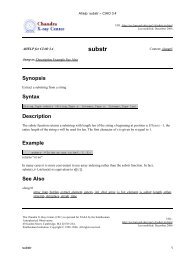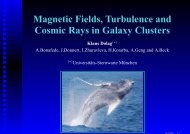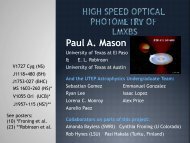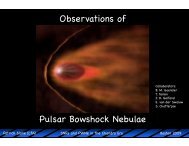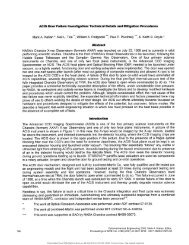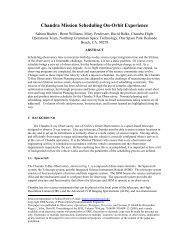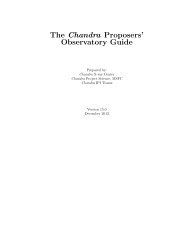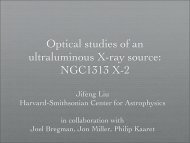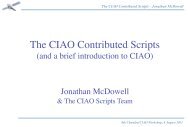PDF Version - Chandra X-Ray Observatory (CXC)
PDF Version - Chandra X-Ray Observatory (CXC)
PDF Version - Chandra X-Ray Observatory (CXC)
You also want an ePaper? Increase the reach of your titles
YUMPU automatically turns print PDFs into web optimized ePapers that Google loves.
10<br />
the focal plane. In previous years, a heater on the ACIS Detector<br />
Housing (DH) and a heater on the SIM were turned<br />
off to provide more margin for the ACIS FP temperature.<br />
At this point in the mission, there are two effects that produce<br />
excursions in the FP temperature, both related to the<br />
attitude of the satellite. First the Earth can be in the FOV of<br />
the ACIS radiator (which provides cooling for the FP and<br />
DH). Second, for pitch angles larger than 130 degrees, the<br />
Sun illuminates the shade for the ACIS radiator and the<br />
rear surfaces of the SIM surrounding the ACIS DH. Reducing<br />
the number of operational CCDs reduces the power<br />
dissipation in the FP, thereby resulting in a lower FP temperature.<br />
Starting in Cycle 13, GOs were encouraged to request<br />
5 CCDs for their observations to keep the FP and the<br />
electronics cooler, if their science objectives could be met<br />
with 5 CCDs. Starting in Cycle 14, GOs will not be allowed<br />
to specify “Y” for 6 CCDs in the RPS forms when they submit<br />
their proposal. If a GO requires 6 CCDs for their observation,<br />
they are to specify 5 CCDs as “Y” and one CCD as<br />
“OPT1” at the time of proposal submission. If the proposal<br />
is selected, the GO may work with their User Uplink Support<br />
Scientist and change the “OPT1” to a “Y” if the sixth<br />
CCD is required. GOs should be aware that requesting 6<br />
CCDs increases the likelihood of a warm FP temperature<br />
and/or may increase the complexity of scheduling the observation.<br />
GOs should review the updated material in the<br />
Proposers’ Guide on selecting CCDs for their observations<br />
and on this web page: http://cxc.cfa.harvard.edu/acis/optional_CCDs/optional_CCDs.html<br />
The control of the ACIS electronics temperatures<br />
has also been a concern for the ACIS Operations Team.<br />
ACIS has three main electronics boxes, the Power Supply<br />
and Mechanisms Controller (PSMC), the Digital Processing<br />
Assembly (DPA), and the Detector Electronics Assembly<br />
(DEA). The PSMC reaches its highest temperatures when<br />
the satellite is in a “forward Sun” configuration, pitch angles<br />
between 45–60 degrees (<strong>Chandra</strong> cannot point within 45<br />
degrees of the Sun). Since 2006, the <strong>Chandra</strong> FOT has been<br />
using the optional CCDs information provided by GOs to<br />
turn off optional CCDs if thermal conditions require. As a<br />
result of the changing thermal environment, the DEA and<br />
DPA are reaching higher temperatures in tail-Sun orientations<br />
(pitch angles larger than 130 degrees). The recommendation<br />
in the previous paragraph to use only 5 CCDs<br />
if the science objectives can be met with 5 CCDs, will also<br />
reduce the temperature of the DEA and DPA in addition to<br />
the temperature of the FP. Starting in Cycle 14, the <strong>Chandra</strong><br />
FOT will be using the optional CCDs information to turn<br />
off optional CCDs if either the DEA or DPA approach their<br />
temperature limits.<br />
HRC Update<br />
Ralph Kraft and Junfeng Wang<br />
<strong>CXC</strong> Newsletter<br />
Another year has passed and the HRC continues to operate<br />
normally. There have been no significant changes or<br />
performance anomalies since the last <strong>Chandra</strong> newsletter.<br />
However, as described in detail in Jeremy Drake’s article on<br />
LETG, the <strong>CXC</strong> calibration team felt that the gain loss, and<br />
therefore quantum efficiency loss (40% or more at some locations),<br />
due to charge extraction in the wing plates of the<br />
HRC-S was sufficiently large that it would start to impact<br />
science observations. This slow decay in instrument gain<br />
and QE is a well-known effect in microchannel plate (MCP)<br />
detectors, and the HRC was designed with the capability to<br />
raise the high voltage to recover the gain.<br />
Accordingly, a plan was developed (principally by<br />
Mike Juda and the <strong>CXC</strong> Calibration team with the support<br />
of the HRC instrument team) to evaluate the effect of a progressive<br />
increase of the high voltage on both the top and<br />
bottom MCPs and determine how much of the lost QE in<br />
the wing plates could be recovered by a small increase to<br />
the HV. This plan was implemented during a realtime contact<br />
on the morning of January 9th, 2012. A Command<br />
Action Procedure was developed in which the HV on the<br />
HRC-S would be raised above the nominal operating voltage<br />
one digital step at a time while observing HZ 43 with<br />
the LETG inserted (30 cts s -1 in the dispersed spectrum in<br />
the wing plates). The voltages were to be raised by 3 steps<br />
on each plate, or roughly 50 volts above the nominal 1250<br />
V operating voltage. Roughly 10 minutes of data would be<br />
taken at each voltage step so that the progressive change<br />
could be evaluated. This would occur during a realtime telemetry<br />
contact so that the instrument team could continuously<br />
monitor the performance and safety of the instrument.<br />
The HV would be returned to its nominal operating<br />
setting at the end of the experiment.<br />
At the time of writing this article, we are just receiving<br />
the processed data from this experiment. Quick<br />
look realtime analysis at the OCC showed that the detector<br />
performed as expected at the higher voltages and that there<br />
were no problems with increased background or hot spots<br />
in the detector during the operation. The HRC was returned<br />
to its default configuration and seen to be operating<br />
normally at the end of experiment. Preliminary analysis of<br />
the processed data from the first few voltage steps shows<br />
that the source rate did increase by roughly 10% per voltage<br />
step. A more careful analysis is underway by both the <strong>CXC</strong><br />
Cal and HRC instrument teams to evaluate the effect on<br />
gain and QE. If the data shows that we recover most or all



